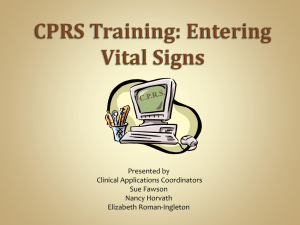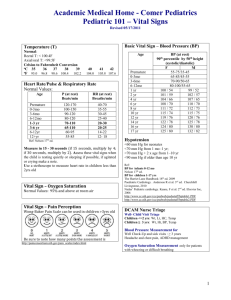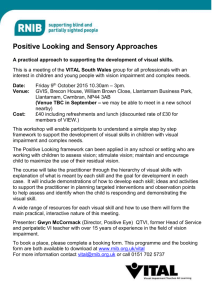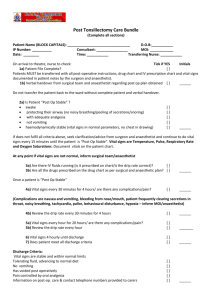Now that I'm Tenured, Where do I go from here
advertisement
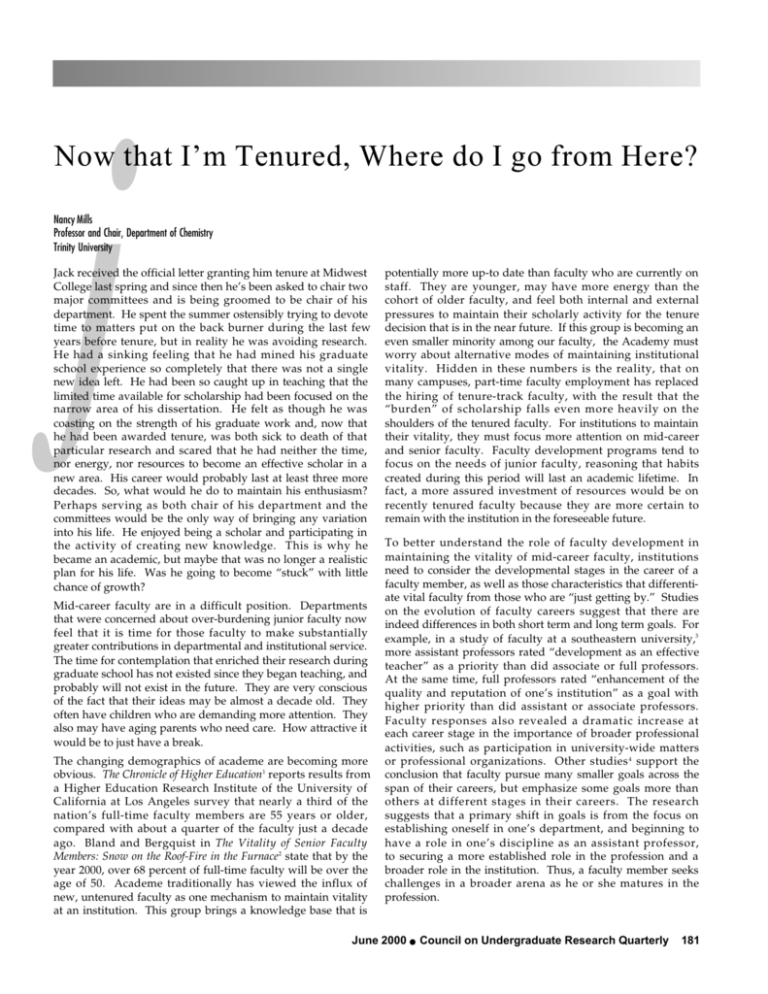
j Now that I’m Tenured, Where do I go from Here? the vitality of mid-career faculty Nancy Mills Professor and Chair, Department of Chemistry Trinity University Jack received the official letter granting him tenure at Midwest College last spring and since then he’s been asked to chair two major committees and is being groomed to be chair of his department. He spent the summer ostensibly trying to devote time to matters put on the back burner during the last few years before tenure, but in reality he was avoiding research. He had a sinking feeling that he had mined his graduate school experience so completely that there was not a single new idea left. He had been so caught up in teaching that the limited time available for scholarship had been focused on the narrow area of his dissertation. He felt as though he was coasting on the strength of his graduate work and, now that he had been awarded tenure, was both sick to death of that particular research and scared that he had neither the time, nor energy, nor resources to become an effective scholar in a new area. His career would probably last at least three more decades. So, what would he do to maintain his enthusiasm? Perhaps serving as both chair of his department and the committees would be the only way of bringing any variation into his life. He enjoyed being a scholar and participating in the activity of creating new knowledge. This is why he became an academic, but maybe that was no longer a realistic plan for his life. Was he going to become “stuck” with little chance of growth? Mid-career faculty are in a difficult position. Departments that were concerned about over-burdening junior faculty now feel that it is time for those faculty to make substantially greater contributions in departmental and institutional service. The time for contemplation that enriched their research during graduate school has not existed since they began teaching, and probably will not exist in the future. They are very conscious of the fact that their ideas may be almost a decade old. They often have children who are demanding more attention. They also may have aging parents who need care. How attractive it would be to just have a break. The changing demographics of academe are becoming more obvious. The Chronicle of Higher Education1 reports results from a Higher Education Research Institute of the University of California at Los Angeles survey that nearly a third of the nation’s full-time faculty members are 55 years or older, compared with about a quarter of the faculty just a decade ago. Bland and Bergquist in The Vitality of Senior Faculty Members: Snow on the Roof-Fire in the Furnace2 state that by the year 2000, over 68 percent of full-time faculty will be over the age of 50. Academe traditionally has viewed the influx of new, untenured faculty as one mechanism to maintain vitality at an institution. This group brings a knowledge base that is potentially more up-to date than faculty who are currently on staff. They are younger, may have more energy than the cohort of older faculty, and feel both internal and external pressures to maintain their scholarly activity for the tenure decision that is in the near future. If this group is becoming an even smaller minority among our faculty, the Academy must worry about alternative modes of maintaining institutional vitality. Hidden in these numbers is the reality, that on many campuses, part-time faculty employment has replaced the hiring of tenure-track faculty, with the result that the “burden” of scholarship falls even more heavily on the shoulders of the tenured faculty. For institutions to maintain their vitality, they must focus more attention on mid-career and senior faculty. Faculty development programs tend to focus on the needs of junior faculty, reasoning that habits created during this period will last an academic lifetime. In fact, a more assured investment of resources would be on recently tenured faculty because they are more certain to remain with the institution in the foreseeable future. To better understand the role of faculty development in maintaining the vitality of mid-career faculty, institutions need to consider the developmental stages in the career of a faculty member, as well as those characteristics that differentiate vital faculty from those who are “just getting by.” Studies on the evolution of faculty careers suggest that there are indeed differences in both short term and long term goals. For example, in a study of faculty at a southeastern university,3 more assistant professors rated “development as an effective teacher” as a priority than did associate or full professors. At the same time, full professors rated “enhancement of the quality and reputation of one’s institution” as a goal with higher priority than did assistant or associate professors. Faculty responses also revealed a dramatic increase at each career stage in the importance of broader professional activities, such as participation in university-wide matters or professional organizations. Other studies 4 support the conclusion that faculty pursue many smaller goals across the span of their careers, but emphasize some goals more than others at different stages in their careers. The research suggests that a primary shift in goals is from the focus on establishing oneself in one’s department, and beginning to have a role in one’s discipline as an assistant professor, to securing a more established role in the profession and a broader role in the institution. Thus, a faculty member seeks challenges in a broader arena as he or she matures in the profession. June 2000 ● Council on Undergraduate Research Quarterly 181 For faculty who have achieved tenure, the forces that affect professional performance are, for the most part, internal rather than external. Faculty are motivated primarily by factors intrinsic to the academic career and are least motivated by financial rewards.3 Therefore, it behooves the Academy to better understand the differences between vital faculty and those less engaged in their profession. Roger Baldwin of the College of William and Mary did an extensive study of vital and “less engaged” faculty at four primarily liberal arts colleges in the Southeast.5 As might be expected, there are many similarities in the two groups. Faculty from both groups agree that teaching is their primary interest, followed by research and scholarship, outside professional activities and services, and administrative and institutional service. Both groups cited students and autonomy as sources of satisfaction, and felt that they had considerable professional strength, such as their teaching skills, knowledge of their professional fields, and rapport with students. Bureaucracy and the routine of academic life were nearly universal sources of dissatisfaction. The differences between the two groups are, of course, more telling. The “less engaged” faculty spend an average of nearly 10 percent more time in teaching and teaching-related activities than do those in the vital category. Those in the later category consistently invest more time in research and administrative or institutional services. Vital faculty work longer hours and have more diversified and more balanced work lives. Vital faculty are consistently more professionally active and productive. They write more papers and books, obtain more grants, and make more presentations at professional meetings. Interestingly, a substantially larger percentage of vital faculty (more than three out of four) engages in collaborative work, such as team teaching, cooperative research, and joint authorship. They also tend to take professional risks, such as experimenting with teaching strategies and moving into interdisciplinary fields. A larger portion of vital faculty than “less engaged” faculty have made significant changes in their work roles. This includes moving into administration and teaching in new areas. Vital faculty sense a need to make a change in their lives and to act on this need. Less than one-half of the vital faculty reported feeling “stuck” at a career plateau, while 62 percent of the “less engaged” faculty acknowledged such a perception. More of the vital faculty cited environmental factors that had contributed to their success than “less engaged” faculty. Nearly one-half of the vital professors stated that administrators had helped them in some way, whereas only 20 percent of “less engaged” faculty reported the same administrative support. Questions on long- and short-term goals show that vital faculty have more easily tested specific prospects they hoped to accomplish in a relatively short period of time. They appear to have more concrete and more immediate goals. “Focused, achievable goals of this nature may serve to stimulate and direct faculty work efforts.”5 182 It remains to ask whether it is possible to create a climate in which a larger percentage of faculty are perceived as vital. We have a “chicken and egg” question. Do the differences between vital faculty and “less engaged” faculty exist because of intrinsic differences between the two groups, or can institutions intervene to help faculty maintain their vitality or become revitalized? It seems obvious that the greater the overlap between the goals of individuals and those of the institution, the greater is the likelihood that the individuals will feel valued and rewarded, and the more incentives they will have to maintain their activity. It also is apparent that institutional cultures that allow, and value, variations in the normal progression of academic careers are more likely to allow the multifaceted careers evident in vital faculty. The careers of science faculty are particularly problematic, and I speak here as a chemist. A traditional and professionally acceptable role of faculty development is research, particularly funded research. Unfortunately, funding agencies view a gap in research productivity as de facto evidence of diminished interest in scholarship. Thus a faculty member who “steps out” of research for a stint as an administrator finds it very difficult to return to research at the same level of productivity as before. If institutions accept the premise that a variety of activities are good for both the faculty and the institution, they must explore ways of enhancing faculty re-entry into research. Studies show that faculty value financial rewards less than intangible rewards. Thus, the excuse that money is lacking for rewards is not valid. Acknowledgment of efforts, as well as of successes, is far more effective than probably realized by both faculty and administrators. A handwritten note from an administrator who said that the activity in which we had both been involved “made me proud to be on the same faculty with you” touched me more than I would have imagined. While vital faculty seem to intuitively understand those activities that will allow them to maintain their vitality, institutions can play an important role in helping other faculty to recognize these activities. Dr. Michael Nelson, Dean of Sciences and Allied Health at the University of Wisconsin – La Crosse, suggests the active intervention of deans in designing programs of faculty development tailored for each faculty member. He advocates a regular discussion with faculty, completely distinct from any evaluation for salary increases or promotion/tenure. These discussions often begin with the question “What is it that the institution can do to make you more effective in your professional activities?” Frequently, the cost of these requests is relatively small, perhaps some software that could not be accommodated in a departmental budget, or a temporary adjustment in faculty load. Having established the interest of the institution in working with the faculty member, they then establish goals for the next year, the next two years, and an appropriate period of time beyond that. Since studies have shown that “vital” faculty have more short-term goals, the aid of a colleague in articulating these goals should have a positive effect on all faculty. It is important that these conversations are held with all faculty, not just those faculty perceived to be “stuck” because it is important that this developmental effort not be pejorative. Council on Undergraduate Research Quarterly ● June 2000 It also is important to realize that the most effective faculty are ones whose interests and strengths match those of the institution. When tenure decisions are made, these matches are evaluated. However, faculty and institutions change. It is not always appropriate, nor desirable, to change the criteria on which faculty are evaluated in order to respond to these changes, because the new criteria may not match the needs of the institution. However, when constructive discussions between faculty and administrators can result in a better fit, both parties benefit. It is important that changes suggested by an administration are valued appropriately in terms of promotion and salary increases. If an activity is not going to be valued by the institution, then it is inappropriate to suggest it to the faculty member. The Council on Undergraduate Research (CUR) was established to promote the scholarship of faculty with undergraduate collaborators, to make that scholarship visible to the larger community, and to aid faculty in becoming more research active. Among the reasons for this support of research at predominantly undergraduate institutions is the importance of research as education, and its importance in the on-going development of faculty strengths. Thus, maintaining the active interest of mid-career faculty in research is a goal of CUR. It is tempting to suggest that CUR lobby funding agencies for support specifically targeted toward mid-career faculty. While it would be nice for granting agencies to recognize that “stepping out” of research for a period of time while becoming involved in administration does not reflect a philosophical change in one’s long-term interest in research, the reality is that funding agencies really cannot justify a gamble on a faculty member who is not currently research active. Thus, the institution has the responsibility to invest in these faculty so that they again become competitive. Putting substantial resources into faculty development for mid-career faculty may be a philosophical shift for many institutions that have put the majority of their resources into developing untenured faculty. Often, faculty development programs offer a stipend for faculty, but very limited funds for supplies or support for students. For a science faculty member to re-establish a research program at the level of publishable results, money for supplies is a minimum requirement. If this money is unavailable from the departmental budget, other sources of support must be sought. It also is desirable to couple this support, where possible, with support for students. Pragmatically, if one wishes a faculty member to be competitive for external funds, the most important result is the re-establishment of a research program in which publishable research is done. The involvement of students in not essential. Philosophically, however, if the Academy feels that research is a crucial part of a student’s education, we should forge those ties wherever possible. The importance of administrative support cannot be overestimated. It takes money to do science, as well as time. If neither is available, the faculty most likely will stagnate. It also is important for faculty to recognize the benefits of collaboration. As shown by Roger Baldwin’s study, vital faculty are also more involved in collaborations than faculty with lower levels of activity. The synergism that is an integral part of good collaborations makes the effectiveness of each faculty member greater than when they are working in isolation. An appropriate administrative response to recognize the value of collaboration would be granting limited funds that allow travel to the location of a potential collaborator. As is apparent, there are a variety of ways in which an institution can maintain the vitality of its tenured faculty. For some, re-involvement in research, the traditional avenue of faculty development, is appropriate. For others, a focus on pedagogical and curricular issues may be a rich area to explore. New roles in service-related activities may also create the kind of excitement that reinvigorates a faculty member. Creating a program for this type of faculty development is best done as a joint effort between faculty and administrators. When done by administrators alone (the top down approach), faculty usually believe that the plan and its resulting expectations are being imposed on them. On the other hand, faculty designing such a program alone do not have access to the necessary resources. CUR has responded to this dilemma by creating a CUR institute entitled the “Vital Faculty: Issues after Tenure.” At the institute, teams of three to five people, including an administrator at the level of dean or higher, are given information about faculty development programs targeted at tenured faculty. The teams are partnered with a facilitator and given opportunities to create such a faculty development program for their own institution. Thus, when the team returns to its home institution, it does so with a plan that has implicit support from the administration, because it was designed with administrative input. The response from faculty attending previous institutes has been very positive. In summary, it is possible for institutions and faculty to work together to maintain the vitality of mid-career faculty. These efforts can involve activities with minor financial impact, such as administrative acknowledgment of faculty efforts, and implementation of a process of formative faculty assessment. However, investment of faculty development resources in mid-career faculty careers also will be necessary if faculty are to re-establish research programs. The advantages to faculty and institutions alike of maintaining the vitality of faculty are apparent and it now remains for institutions to respond effectively. (You are invited to attend a CUR Institute on The Vital Faculty: Issues After Tenure at the University of Wisconsin - La Crosse, March 2-4, 2001.) References 1) Manger, D. K. (1999). The Graying Professoriate. Vol. 46, pp A18-A21. 2) Bland, C. J., Bergquist, W. H. (1997). The Vitality of Senior Faculty: Snow on the Roof, Fire in the Furnace. Vol. 25, number 7. 3) Kalivoda, P, Sorrell, G. R., Simpson, R. D. (1994). Innovative Higher Education. 255-272. 4) Baldwin, R. G. Adult and Career Development: What are the implications for faculty? (1979). AAHE: Washington, D. C. 5) Baldwin, R. G. (1990). Jn. of Higher Ed. 61, 160-180. June 2000 ● Council on Undergraduate Research Quarterly 183


